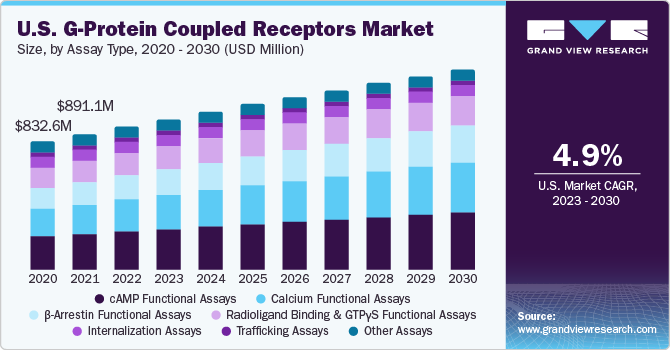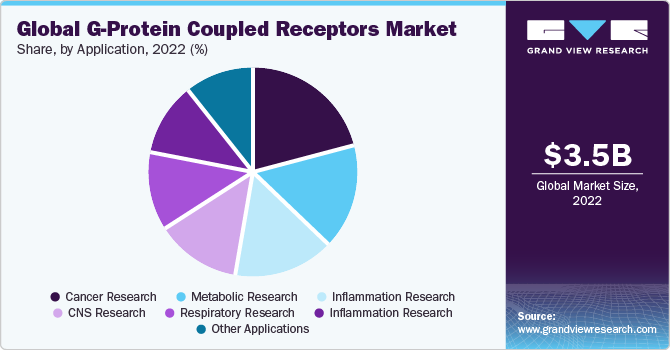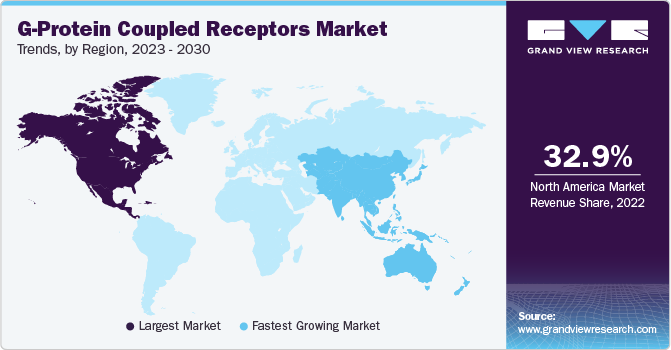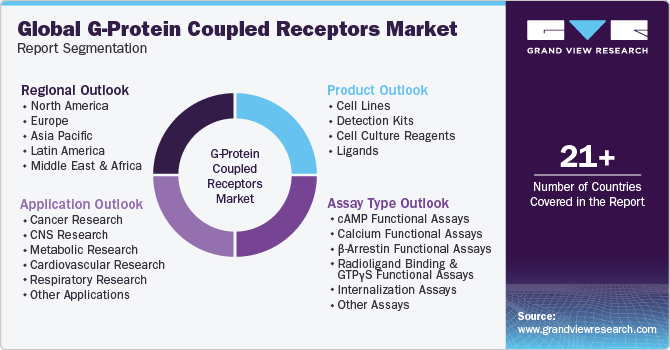- Home
- »
- Biotechnology
- »
-
G-Protein Coupled Receptors Market Size Report, 2030GVR Report cover
![G-Protein Coupled Receptors Market Size, Share & Trends Report]()
G-Protein Coupled Receptors Market Size, Share & Trends Analysis Report By Product (Cell Lines, Detection Kits, Cell Culture Reagents, Ligands), By Assay Type, By Application, By Region, And Segment Forecasts, 2023 - 2030
- Report ID: GVR-3-68038-224-2
- Number of Report Pages: 135
- Format: PDF, Horizon Databook
- Historical Range: 2018 - 2021
- Forecast Period: 2023 - 2030
- Industry: Healthcare
GPCRs Market Size & Trends
The global G-protein coupled receptors market size was valued at USD 3.46 billion in 2022 and is anticipated to grow at a compound annual growth rate (CAGR) of 5.1% from 2023 to 2030. G-protein coupled receptors (GPCRs), also known as seven-transmembrane receptors, bind the chemicals and transmit signals. These GPCRs have effectively identified pharmaceutically relevant drug candidates, which drives their adoption in drug discovery processes. The presence of many approved drugs, as well as drugs under clinical and preclinical studies, which target these receptors, boosts the demand for GPCR screening assays in drug development. Moreover, increasing allosteric modulators, biological drugs, and biased agonists targeting these receptors are accelerating the demand for associated assays.

Due to the rise in lifestyle-related diseases such as cancer, cardiovascular and respiratory diseases, the G-protein coupled receptors industry is expected to grow significantly. Increasing governmental expenditures for research & development purposes for new drugs and therapies is also one of the key drivers of this market. The development of many drugs that require and target these receptors boosts this market. However, the high costs associated with these cell lines pose a challenge to market growth. Also, the need for more skilled medical professionals and trained experts is acting as a market restraint.
Advancements in computational approaches to streamline receptor structure contribute to developing effective drug discovery methods. For instance, in April 2019, researchers from the University of Southern California, the Skolkovo Institute of Science & Technology, and the Moscow Institute of Physics & Technology designed a computational method for developing thermally stable GPCR to formulate new drugs.
Companies in the market focus more on research to explore the novel biological functions of the approved and withdrawn drug candidates. These can also be used for other indications. A research based on a custom-designed oligonucleotide GPCR chip by Arena Pharmaceuticals has identified a relative expression of more than seven hundred receptors of high therapeutic importance. This research would be further utilized for the discovery of small molecules.
Drugs that target the GPCRs have shown the potential to alleviate COVID-19 symptoms. They tend to reduce the pathogenic symptoms associated with this disease. Since these receptors were significant in drug discovery in the initial phase of COVID-19, this market showed significant growth in the initial phase of the outbreak. However, when the pandemic subsided and the R&D activities slowed, the market also witnessed a downfall, although it is expected to maintain stable growth in the forecast period.
Product Insights
Based on products, the G-protein coupled receptors market is segmented into cell lines, detection kits, cell culture reagents, and ligands. The cell lines segment dominated the market with the largest revenue share in 2022, owing to the availability of an extensive range of cell lines for the assays. Cell lines play a major role in the cellular impedance assays for detecting GPCR targets, thus contributing to the strong revenue share.
On the other hand, detection kits have gained popularity in recent years, as they are easy-to-use, robust, and highly sensitive products used to evaluate activity through different pathways. Moreover, new detection strategies based on non-labeled systems, such as resonance wave-guide grating or impedance-based sensors, are anticipated to support the segment's growth.
Assay Type Insights
The cAMP functional assays segment dominated the market with the largest revenue share in 2022, because cyclic Adenosine Monophosphate (cAMP) is an important intracellular second messenger in GPCR signal transduction. The extensive range of reagent kits available for measuring cAMP messenger levels is significantly boosting the segment's growth.
Based on assay type, the GPCRs market is segmented into cAMP functional assays, calcium functional assays, β-arrestin functional assays, radioligand binding and GTPγS functional assays, internalization assays, trafficking assays, and other assays. The calcium functional assays segment is expected to expand at the fastest CAGR over the forecast period because of the advantages associated with using calcium flux assays, such as high sensitivity, ease in the estimation of calcium flux, and user configurability.
Application Insights
The cancer research segment held the largest revenue share of 20.9% in the market in 2022. A substantial number of applications are associated with G-protein coupled receptor activity for the treatment of several disorders. The majority of tumor angiogenesis and immunotherapy-related detections are associated with GPCR activity. The ubiquitously expressed protein is involved in intercellular communication that paves the path for the development of potential therapeutics. Implementation of GPCR assays in cancer research generates substantial revenue.

Several studies have proved that GPCR activity reveals tumor proliferation, invasiveness, angiogenesis, metastasis, and drug resistance in cancer patients. As per research, each product of cancer cell/tumor is found to express a common set of GPCRs. It has also been observed that >150 different GPCRs are expressed by some products of cells, out of which one is expressed at a comparatively high level. Based on application, the market for G-protein coupled receptors is segmented into cancer research, CNS research, metabolic research, cardiovascular research, respiratory research, and inflammation research, among others.
The inflammation research segment is expected to advance at the fastest CAGR of 5.9% over the forecast period. The role of this receptor has evolved in the inflammation research area in recent years. G-protein coupled receptor kinases regulate signaling pathways, such as the nuclear factor κ-B signaling pathway, which is related to different inflammatory processes. Thus, these signaling pathways act as a potential therapeutic target in various inflammatory diseases.
Regional Insights
North America dominated the GPCRs market with the largest revenue share of 32.9% in 2022 due to strategic investments in cancer research, approval of GPCR-targeted drugs, and increased focus on drug discovery & development activities in the region. In November 2017, 134 GPCR targets for drugs were approved in U.S. or European Union and 128 targets were listed in the FDA orange book.

The Asia Pacific region is anticipated to expand at the highest CAGR of 5.7% over the forecast period due to the presence of several emerging companies, such as Sosei Heptares, HD Biosciences Co., Ltd., and NB Health Laboratory. The number of initiatives undertaken by companies to improve their market presence drives regional growth. Additionally, rising cases of lifestyle disorders in the growing population of India, China, and other economies, and the need to cure them with receptors, drive regional expansion.
Key Companies & Market Share Insights
Mergers, acquisitions, and licensing deals for R&D activities are the key strategies undertaken by leading companies to maintain their market presence. Moreover, they are integrating automation and innovative technologies with drug development screening procedures to improve their capabilities in therapeutic production. For instance, in 2021, Tectonic Therapeutic announced its launch with a successful Series A financing of USD 80 million. The company aims to revolutionize the discovery of novel therapies targeting G-protein coupled receptors (GPCRs).
Similarly, in December 2022, Sosei Group Corporation announced its partnership with Eli Lilly and Company, a global biopharmaceutical firm. The collaboration aims to facilitate drug discovery for novel G protein-coupled receptor (GPCR) targets linked to diabetes and metabolic diseases, including the development and commercialization of small molecules with therapeutic potential.
In another development, in August 2022, Sosei Group Corporation and AbbVie Inc., a research-based global biopharmaceutical company, announced a new drug discovery partnership and option-to-license agreement. The primary objective of this collaboration is to identify, develop, and bring to market small molecules that effectively modulate novel G-protein-coupled receptor (GPCR) targets associated with neurological diseases. Some of the major participants in the global G-protein coupled receptors market include:
-
Thermo Fisher Scientific Inc.
-
Eurofins Scientific
-
QIAGEN
-
WuXi AppTec
-
Promega Corporation
-
Abcam plc
-
Merck KGaA
-
PerkinElmer Inc.
-
Enzo Biochem Inc.
-
BD
G-Protein Coupled Receptors Market Report Scope
Report Attribute
Details
Market size value in 2023
USD 3.68 billion
Revenue Forecast in 2030
USD 5.23 billion
Growth rate
CAGR of 5.1% from 2023 to 2030
Base year for estimation
2022
Historical data
2018 - 2021
Forecast period
2023 - 2030
Report updated
October 2023
Quantitative units
Revenue in USD million/billion and CAGR from 2023 to 2030
Report Coverage
Revenue forecast, company ranking, competitive landscape, growth factors, and trends
Segments Covered
Product, assay type, application, region
Regional scope
North America; Europe; Asia Pacific; Latin America; MEA
Country scope
U.S.; Canada; U.K.; Germany; France; Italy; Spain; Denmark; Sweden; Norway; China; Japan; India; Australia; South Korea; Thailand; Brazil; Mexico; Argentina; Saudi Arabia; South Africa; UAE; Kuwait
Key companies profiled
Thermo Fisher Scientific Inc.; Eurofins Scientific; QIAGEN; WuXi AppTec; Promega Corporation; Abcam plc; Merck KGaA; PerkinElmer Inc.; Enzo Biochem Inc.; BD
Customization scope
Free report customization (equivalent up to 8 analyst’s working days) with purchase. Addition or alteration to country, regional & segment scope
Pricing and purchase options
Avail customized purchase options to meet your exact research needs. Explore purchase options
Global G-Protein Coupled Receptors Market Report Segmentation
This report forecasts revenue growth at the global, regional, and country levels and provides an analysis of the latest industry trends in each of the sub-segments from 2018 to 2030. For the purpose of this study, Grand View Research has segmented the global G-protein coupled receptors market report on the basis of product, assay type, application, and region:

-
Product Outlook (Revenue, USD Million, 2018 - 2030)
-
Cell Lines
-
Detection Kits
-
Cell Culture Reagents
-
Ligands
-
-
Assay Type Outlook (Revenue, USD Million, 2018 - 2030)
-
cAMP Functional Assays
-
Calcium Functional Assays
-
β-Arrestin Functional Assays
-
Radioligand Binding & GTPγS Functional Assays
-
Internalization Assays
-
Trafficking Assays
-
Other Assays
-
-
Application Outlook (Revenue, USD Million, 2018 - 2030)
-
Cancer Research
-
CNS Research
-
Metabolic Research
-
Cardiovascular Research
-
Respiratory Research
-
Inflammation Research
-
Other Applications
-
-
Regional Outlook (Revenue, USD Million, 2018 - 2030)
-
North America
-
U.S.
-
Canada
-
-
Europe
-
U.K.
-
Germany
-
France
-
Italy
-
Spain
-
Denmark
-
Sweden
-
Norway
-
-
Asia Pacific
-
Japan
-
China
-
India
-
Australia
-
Thailand
-
South Korea
-
-
Latin America
-
Brazil
-
Mexico
-
Argentina
-
-
Middle East & Africa
-
South Africa
-
Saudi Arabia
-
UAE
-
Kuwait
-
-
Frequently Asked Questions About This Report
b. The global G-protein coupled receptors market size was estimated at USD 3.46 billion in 2022 and is expected to reach USD 3.68 billion in 2023.
b. The global G-protein coupled receptors market is expected to grow at a compound annual growth rate of 5.1% from 2023 to 2030 to reach USD 5.23 billion by 2030.
b. Some of the market opportunities for market growth include the advancements in the understanding of GPCR biology in oncology for the development of combined therapies and technological advancements in the market.
b. Key factors that are driving the market growth include growing demand for GPCR assays in drug discovery studies; wide application of GPCRs in the treatment for various medical conditions; the rising number of initiatives by government and key players.
b. Some key players operating in the G-protein coupled receptors market include Thermo Fisher Scientific, Inc.; Eurofins Scientific; QIAGEN; WuXi AppTec(HD Biosciences Co. Ltd); Promega Corporation; Abcam plc; Perkin Elmer Inc.(Cisbio Bioassays); Enzo Biochem Inc.; Merck KGaA; and Becton-Dickinson and Company.
Share this report with your colleague or friend.
![gvr icn]()
NEED A CUSTOM REPORT?
We can customize every report - free of charge - including purchasing stand-alone sections or country-level reports, as well as offer affordable discounts for start-ups & universities. Contact us now
![Certified Icon]()
We are GDPR and CCPA compliant! Your transaction & personal information is safe and secure. For more details, please read our privacy policy.
We are committed towards customer satisfaction, and quality service.
"The quality of research they have done for us has been excellent."





